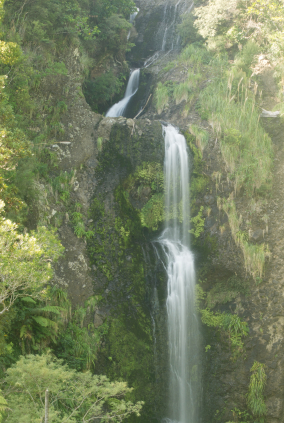Biohabitats ecologist Suzanne Hoehne is spending a month in Auckland, New Zealand, as part of a Rotary Group Study Exchange program. Suzanne promised to keep us up to date on her adventure, and we’re delighted to share her most recent post:
For my first vocational day, I had the opportunity to meet with Dr. Naresh Singhal, a professor at the University of Auckland, and a few of his doctoral students. Being in such a small country, each professor has a broad area of focus due to the funding structure. The focus of the group I met with is water quality.

A waterfall in the Waitakere Ranges
One area of study currently underway is how to best improve the quality of Auckland’s water supply, a reservoir system similar to that of New York City. The reservoirs are in the Waitakere Ranges west of the city, and the water quality has been declining. The Waitakere Ranges have been preserved by the Auckland Metro Council as a bush reserve for the conservation of native flora and fauna since the late 1890s. Before that they were heavily logged and subsequently tried for farming, but the land was too steep and the soil too poor to support agriculture. The ranges receive twice as much rainfall as the rest of Auckland, so they are an ideal site for a water supply system. Currently, five reservoirs within the area supply water to the Auckland region. The goal of the study is to determine whether it will be easier to control the source of the pollutant or to remove the pollutant after it has entered the system.
In the afternoon, I met with two ecologists from the Auckland Metro Council. They invited me to partake in a field visit up north to a piece of property that the Metro Council had just acquired south of the Puhoi River along the coast. We were setting fish traps to determine the current fish species present in the stream network on the property. The property is to be set up as a model farm, to showcase ecologically friendly farming practices. It is some of the steepest terrain I have ever seen currently farmed for livestock. In the U.S., most areas that steep are set aside as woodlots or converted back to forest. The grazing is intense, and in places has cause massive slope failures. The stream channel is quite entrenched in places and has aggradation and headcutting throughout its upper length. The government is encouraging landowners to fence off stream corridors from livestock access to help reduce sediment loading.
In all, it was a very informative day into some of the issues and efforts to address them here in Auckland.
Further Reading
Meet Assistant Construction Project Team Leader Bryan SullivanMeet Conservation Biologist Nolan Schillerstrom
Get to know Allyson Gibson, Biohabitats Extern
Get to Know Graphic Designer Joey Marshall
Evolution: A New Leadership Team for Biohabitats
More From This Author
An American Ecologist in New Zealand Part V: What is a Cittaslow?An American Ecologist in New Zealand Part VI: Green Infrastructure for SWM
An American Ecologist in New Zealand: Part II
Aloha: An unforgettable trip to the bathroom
How does Biomimicry Relate to Stream Restoration?

